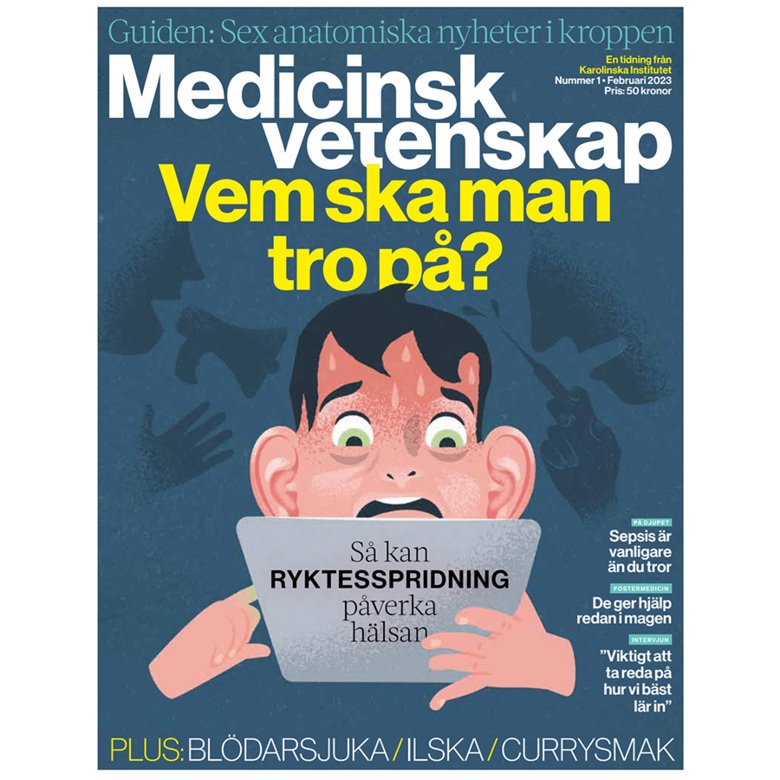Improved blood testing could help sepsis patients

How should healthcare providers identify bacteria or other pathogens in the blood of sepsis patients as quickly as possible? Volkan Özenci is focusing on this in his research. This article is part of an in-depth feature from KI's popular science magazine Medicinsk Vetenskap.
Volkan Özenci is a consultant in clinical microbiology at Karolinska University Laboratory in Huddinge and a researcher at the Department of Laboratory Medicine at Karolinska Institutet.

Text: Annika Lund for the magazine Medicinsk Vetenskap no 1, 2023 | Spotlight on sepsis
Why is this important?
– We know from studies that only two out of three sepsis patients receive the right antibiotic therapy from the outset. So after microbiological blood tests, about one in three patients needs a change of therapy. This might involve tapering, moving from broad-spectrum antibiotics to narrow-spectrum antibiotics, which are better from a resistance perspective and easier on the patient. But it might also involve broadening treatment to tackle bacteria presenting resistance problems.
How are you researching this?
– I’m investigating the practical aspects of blood culture workflows. Essentially, there’s plenty of potential for improvement in this area. It’s about all parts of the chain: how the samples are taken, how they’re transported, how they’re analysed and how the information reaches the doctor who has to act on it.
What have you found out about taking samples?
– The volume of blood is important in order to detect bacteria. Samples must contain at least 40 millilitres of blood, which must be taken in four tubes. We’ve shown that nearly one in two blood culture samples taken at three major hospitals in Stockholm contains less blood than this. In general, there’s less blood volume in samples taken from female patients and elderly patients. The volume in samples collected at night is also lower. This does make a difference, because the chance of identifying bacteria in the blood increases by 13 per cent for every millilitre.
Gosh! What are you doing with that information?
– We’re trying to simplify procedures. In one study, we’ve shown that all four tubes can be taken from the same puncture site. It used to be the case that two tubes were taken from one arm and two from the other, but using the same arm provides equal diagnostic confidence.
What else do you have to take into account when collecting blood samples?
– Contamination with skin bacteria is a major problem. The puncture site has to be rubbed with alcohol for at least 30 seconds and allowed to air-dry before the sample is taken. We’ve seen that in COVID-19 patients, 8.4 per cent of blood cultures are contaminated, compared to 5 per cent in a control group without COVID-19. We know from previous studies that stress increases the incidence of contamination.
What else have you investigated?
– We’ve looked at transport times, how long it takes for blood cultures to arrive at the lab. In a study that’s now almost ten years old, we showed that it took an average of nine hours for samples to start being stored in incubators, a kind of advanced heating cabinet where bacteria thrive and divide. We need them to do this so that we can detect them in the blood. It took so long because the lab was closed at night. But since then, we’ve set up incubators in other locations at the hospitals. Samples now end up being placed in incubators within an hour now. That’s a 900 per cent improvement. Doing this has reduced the time to diagnosis, which takes place in several steps: we say first that there are bacteria in the blood, and then we can say what they are.
What pathogens do sepsis patients usually have in their blood?
– Any microorganism can cause sepsis. Bacteria are most common, but yeasts are quite common too, especially after abdominal surgery. Any bacteria can cause sepsis. And so can viruses and parasites.
Is there a top ten?
– Yes. It varies slightly depending on where in the world we are and what age groups we’re talking about. It’s changed over time, too. But at the top there’s usually the skin bacterium Staphylococcus aureus and the intestinal bacterium Escherichia coli, closely followed by other intestinal bacteria, such as Klebsiella pneumoniae.
How often do sepsis patients have bacteria in their blood?
– In our culture studies, we can detect bacteria in the blood of about 30 per cent of our patients. This illustrates why it’s not entirely accurate to talk about blood poisoning – bacteria in the blood aren’t the only problem. There’s also the body’s immunological response to a pathogen, which isn’t necessarily in the blood. But our studies probably give misleadingly low numbers. We reckon that if we got more blood volume from more patients, we’d probably detect bacteria in the blood of more people.
Related feature articles
 Photo: Getty Images,Getty Images/iStockphoto
Photo: Getty Images,Getty Images/iStockphotoSepsis - The hidden killer
 Photo: Getty Images
Photo: Getty Images“Digital sniffer dog” finds patients with sepsis
 Photo: Petter Cohen
Photo: Petter CohenArne lost his toes due to sepsis
 Photo: Linnea Bengtsson
Photo: Linnea BengtssonPetra got sepsis after giving birth
About the magazine Medicinsk Vetenskap
 Photo: Jens Magnusson
Photo: Jens MagnussonRead more articles about medical research
Read about the latest in medical science in Karolinska Institutet's Swedish language popular science magazine Medicinsk Vetenskap. Subscribe now!
